Mary Lee Bendolph - Gee's Bend, Alabama
 Wednesday, October 15, 2008 at 8:16AM
Wednesday, October 15, 2008 at 8:16AM  When we found Mary Lee Bendolph, she was raking the wide cut field that stretches out in front of her home.
When we found Mary Lee Bendolph, she was raking the wide cut field that stretches out in front of her home.

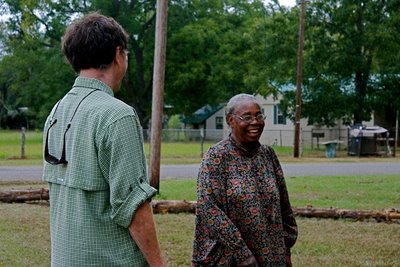 This is perhaps not the expected way to meet a major American artist.
This is perhaps not the expected way to meet a major American artist.
 But art wasn't a word that Mary Lee or other Gee's Bend quilters ever thought to apply to the work they do.
But art wasn't a word that Mary Lee or other Gee's Bend quilters ever thought to apply to the work they do.
 But what words do you have for work like this?
But what words do you have for work like this?
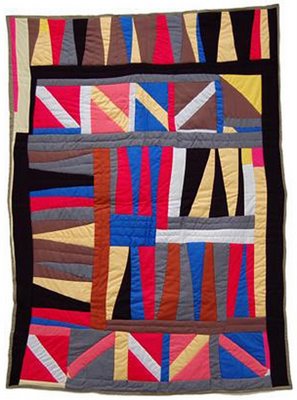 Mary Lee was forced to stop her schooling when she was fourteen. She deeply regrets this.
Mary Lee was forced to stop her schooling when she was fourteen. She deeply regrets this.
When we look at her quilts, we regret that our own schooling didn't end then, too.
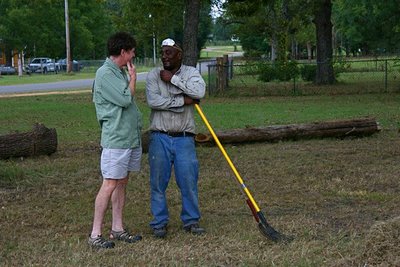 I've cut alot of brush in Big Sur. Mary Lee's son has just cut and cleared this beautiful open field.
I've cut alot of brush in Big Sur. Mary Lee's son has just cut and cleared this beautiful open field.
 This is one of Arthur Rothstein's photographs that he took in Gee's Bend in 1937. Mary Lee was born two years earlier. Her future husband Rubin is one of the small boys in the right center of the photo.
This is one of Arthur Rothstein's photographs that he took in Gee's Bend in 1937. Mary Lee was born two years earlier. Her future husband Rubin is one of the small boys in the right center of the photo.
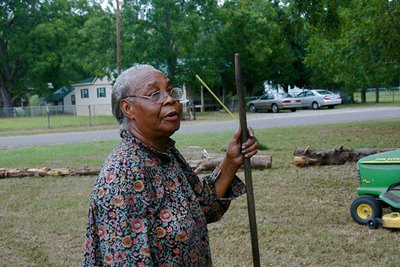 Mary Lee's own Roosevelt home is in the background behind her. It was built in the very spot of that clapboard cabin that Rothstein photographed above. When he took the photograph, he wasn't standing far from where Mary Lee is now.
Mary Lee's own Roosevelt home is in the background behind her. It was built in the very spot of that clapboard cabin that Rothstein photographed above. When he took the photograph, he wasn't standing far from where Mary Lee is now.
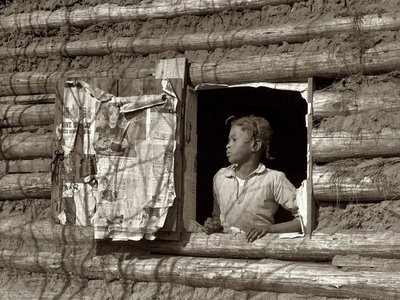 And Mary Lee's current home is also the same spot where Rothstein took this iconic photograph of young Artelia Bendolph.
And Mary Lee's current home is also the same spot where Rothstein took this iconic photograph of young Artelia Bendolph.
 One blustery rainy night in February 1965, a preacher drove up slowly in a caravan of cars along the mud roads of Gee's Bend. "They had a little prayer," Mary Lee says. "They sung a song. And then they turned it over to him." The preacher had a virus and had been losing his voice for days. It was after midnight by the time he spoke. But that night, he made the walls of Pleasant Grove Baptist Church shake.
One blustery rainy night in February 1965, a preacher drove up slowly in a caravan of cars along the mud roads of Gee's Bend. "They had a little prayer," Mary Lee says. "They sung a song. And then they turned it over to him." The preacher had a virus and had been losing his voice for days. It was after midnight by the time he spoke. But that night, he made the walls of Pleasant Grove Baptist Church shake.
Mary Lee had never heard anyone speak like this before.
"He told her that she might not speak with perfect grammar, might not own more than one dress, might not be more than a dirt farmer descended from slaves, but she was every bit as good as those white folks across the river. Tears filled his eyes as he shouted, 'I come over here to Gee's Bend to tell you--you are somebody.'
"No one had ever said that to Mary Lee before."
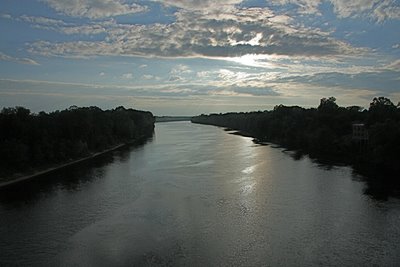 Mary Lee met the preacher again across the river in Camden and gave him a big hug. She saw him in Selma, too, and watched in awe as he drank from a "whites only" drinking fountain.
Mary Lee met the preacher again across the river in Camden and gave him a big hug. She saw him in Selma, too, and watched in awe as he drank from a "whites only" drinking fountain.
"I never saw a black person do a thing like that!" she says. "I was so glad. I said, 'I'm going to get me a taste my own self.'"
Mary Lee has dreams of the future that she always trusts. So when she kept hearing the preacher say that he had a dream, Mary Lee understood.
"I have them too," Mary Lee thought.
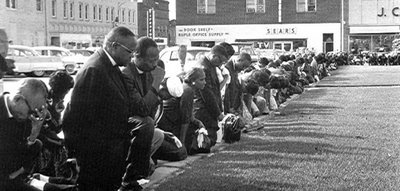 Many Gee's Benders were in Selma when the Voting Rights march began on "Bloody Sunday" in March 1965. Marchers stopped and knelt and prayed when they came to a phalanx of state police who blocked their way at the foot of Edmund Pettus bridge.
Many Gee's Benders were in Selma when the Voting Rights march began on "Bloody Sunday" in March 1965. Marchers stopped and knelt and prayed when they came to a phalanx of state police who blocked their way at the foot of Edmund Pettus bridge.
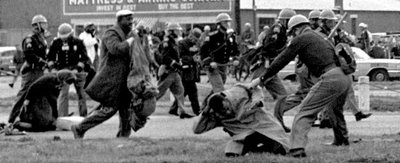 Then the police rushed at them and beat and drove them back.
Then the police rushed at them and beat and drove them back.
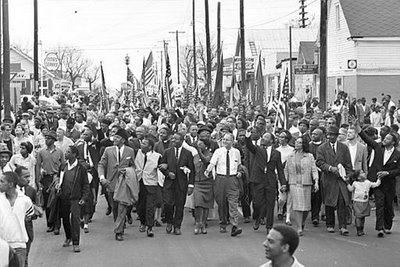 And Gee's Benders were again among the marchers three weeks later when an outraged America forced Lyndon Johnson to send federal troops to protect the march.
And Gee's Benders were again among the marchers three weeks later when an outraged America forced Lyndon Johnson to send federal troops to protect the march.
 When you drive from Atlanta to Gee's Bend, you re-trace that same journey through Selma and Montgomery yourself.
When you drive from Atlanta to Gee's Bend, you re-trace that same journey through Selma and Montgomery yourself.
 You can stand on the steps of the state capitol in Montgomery yourself.
You can stand on the steps of the state capitol in Montgomery yourself.

 And you can re-commit yourself even if you haven't yet paid the price that others have.
And you can re-commit yourself even if you haven't yet paid the price that others have.
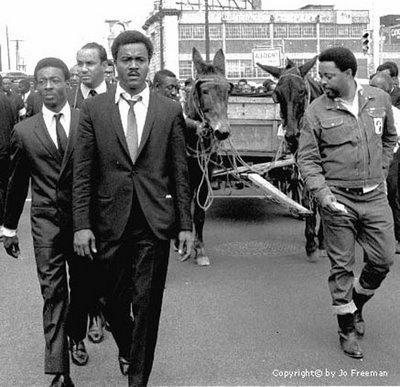 When the preacher was killed, they found two mules to pull his hearse, as symbols of the man's humility and commitment to the poor.
When the preacher was killed, they found two mules to pull his hearse, as symbols of the man's humility and commitment to the poor.
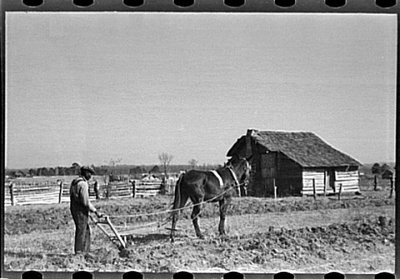 They found the mules in Gee's Bend.
They found the mules in Gee's Bend.
 Sometimes in Mary Lee's dreams, God visits her.
Sometimes in Mary Lee's dreams, God visits her.
 Wait until you meet her before giving assurance to your skepticism about that.
Wait until you meet her before giving assurance to your skepticism about that.
 Gee's Bend,
Gee's Bend,  Mary Lee Bendolph | in
Mary Lee Bendolph | in  Artists,
Artists,  Women at the center
Women at the center 

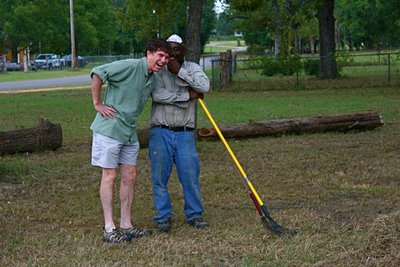
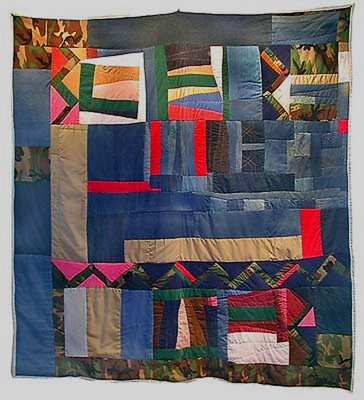
Reader Comments (6)
It is so hard to adequately describe the feelings looking at these civil rights photos. What a time where the vision of some of a world divided was confronted by those with a vision of a world united. Gee's Bend offers the great lesson that our humanity is grounded in the substance fo struggle. What an honor to wintess this history and these beautiful human beings. Thank you too, Chris and DEbi for sharing their beautiful creativity with us too! In peace, LL
The photography and writing on Gee's bend is soooo moving. Crying in my beer here. The quillts look like what jazz sounds like. You guys are doing an a-m-a-z-i-n-g job! Can't wait for your next post:)
Thanks Judy, so good to hear from you! We have jut arrived in Ottawa from Cape Dorset where we didn't have connection for the past few days. Tonight we'll try to post a new entry. Cape Dorset blew our minds so stay tuned. Hope all is well.
I have access to an original photo signed by Rothstein of Artelia Bendolph. Artelia worked for this friend's mother for over 35 years. It is the same photo of Tilly looking out the window.
i just saw the play in cincinnati oh, i was blowed away this is history to me i am on the web trying to look up all the information i can about it i just want to see the real people it is so interesting!!!!!
Didn't even realize that a "Gee's Bend" play had been created, Deborah. Sounds wonderful. And you won't be disappointed if you find a chance to meet the "real people"!